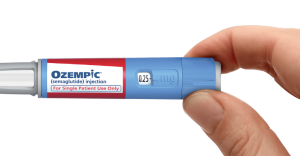-
Is OZEMPIC the weight loss miracle?
It's 'another' timeout during the LVIII Superbowl!
"Oh, oh, oh, Ozempic", the multi-million dollar advertisement starts.

Ozempic is a medication primarily used for treating type 2 diabetes. Though recently, it has been gaining popularity for its potential weight loss effect. As with all medications, Ozempic has its own set of potential benefits and drawbacks. Positive effects may include improved blood sugar control and weight loss, while negative side effects may include nausea, vomiting, or diarrhea.
My experience and observations have led me to believe that weight loss can be achieved by focusing on two things:
Firstly, reducing dietary carbohydrates - specifically, refined sugars and excessive complex starchy carbs. This approach is particularly effective for those who are less tolerant of dietary carbs, as it lowers blood glucose and insulin levels, which can promote stored fat for energy. This, in turn, leads to weight loss.
Secondly, eating less. This can be achieved by manipulating and suppressing the appetite or by controlling one's ideal energy in/energy out ratio. Although the blood sugar paradox plays a role in weight loss, ultimately, it is still a matter of achieving a net in/net out balance. Eating less than you burn will result in weight loss. Controlling the appetite appears to be the tricky bit.
Ozempic and similar medications can help balance blood sugar and suppress the appetite. And, most of the time, people lose weight. However, as with most drugs, there are pros and cons to consider. And reports suggest Ozempic can present cons.
It's crucial to talk to your doctor about the benefits and drawbacks of Ozempic to determine if it's the best treatment for you. Above all, avoid this medication if not prescribed by your Doctor.
Blatant plug: The Reboot24 Program aims to lower blood glucose levels and fine-tune your appetite for better health.
-
How to run strongly in the second half!
It appears that the longer a runner runs, the more their performance is reduced due to a decline in their running posture.
The main obstacle to finishing a long run is not a lack of cardiovascular fitness, an empty energy tank, or shoe choice, but deteriorating postural balance.
When a runner becomes tired, you typically see the following:
❌ Shoulders rounding forward - resulting in the head weighted ahead of the hips.
❌ This causes the bum to stick out at the back.
❌ Consequently, the supporting leg loads ahead of the hips, increasing the impact cost and breaking forward momentum.
A runner holding good back-end form shows:
✅ The head, hips, and landing foot are all in a straight line.
✅ The back is mostly straight, with the head like a golf ball on a tee.
✅ The hips are slightly tilted forward.
✅ The support foot is loaded directly under the hips."
Focusing on proper form and technique can be challenging when you're tired.
"The more I practiced this pre-run postural strength set,
the better my back-end running form".
#
Action
Time/ Reps
1
Running Arms with dumbbells
45 seconds
2
Push Ups on dumbbells
10
3
Dead Bugs with dumbbells
20
4
Running Arms with dumbbells
45 seconds
Press play before your next trot and follow along with this 2-minute tune-up.
You'll feel an instant improvement in balance and flow.
-
Only the Strong!
Is resistance training the anti-aging superpill?
Many exercise physiologists claim that appropriate resistance exercise is the most effective way to combat aging. While cardiovascular activity and stretching are important for maintaining a healthy ticker & range of motion, placing a suitable amount of stress on muscles and bones could be essential in anti-aging.
Resistance training exercises require pushing or pulling an object or your own body against resistance. On the other hand, strength training involves lifting progressively heavier weights with fewer repetitions, targeting larger muscle groups, and significantly increasing overall strength.
"Proven Benefits:
🏋️♂️ Maintaining lean muscle mass is critical for a healthy metabolism and all bodily functions.
🏋️♂️ Significantly reduces the inflammatory response in joints, such as arthritis.
🏋️♂️ Improves bone and joint strength, leading to better posture and coordination.
🏋️♂️ Increases joint lubrication (synovial fluid), decreasing pain and improving range of motion.
🏋️♂️ Boosts neural health, aiding balance."
This is Mum’s (79yrs) Workout @ 4/7/52.
Session time: 12 mins per session @ 48 minutes in her 10,080 minute week (0.4%).
#
Exercise
Sets
Reps
Load (kgs)
Rest (secs)
1
DB Step ups - 20cm box
2
6/6
3
30
2
DB Squat Press
2
8
4
30
3
Box Push ups
2
8
Body
20
4
DB Lateral Raises
2
8
3
20
5
DB Arm Curls
2
10
4
20
6
Lying DB Rotations
2
16
4
20
-
How to wreck a good movie! With popcorn!
In my opinion, movie popcorn might just be the worst snack food.
When you add hydrogenated soybean oil (trans fats), beta-carotene (which gives the popcorn its bright yellow colour), Butylhydroquinone (used to preserve it for hours in the heated chamber), and polydimethylsiloxane (a golden liquid that gives it a buttery taste), you get a canary-coloured popcorn treat/ and health disaster. However, the biggest culprit that can wreak havoc on your gut is flavacol - a seasoning salt that is high in fake sodium and can pitch your blood pressure into next week."
Ultimately, this 'sort-of' food is designed to have you demolish a family box, drain a super-size coke, and buy another one on the way out!
However, not all popcorn is a health hazard. Grab some organic choices and get popping!
-
FOOTLOOSE!
Our feet used to look like this!
Feet are crucial for human movement. They are the contact point between A and B. If they don't do their job, other body parts suffer.
During my trek on the Kokoda Trail, I was amazed to see that the locals were able to complete the 100km journey barefoot. Their feet were impressive, with well-formed muscles and an obvious blood supply. It was evident that their feet had been trained and conditioned, likely due to a lifetime of walking on rough terrain. We called it ‘gym feet’!
I have fond memories of spending my summer school holidays barefoot between the ages of 5 and 15. I always dreaded the first day back to school when I had to wear tight and uncomfortable shoes.
"Strong, responsive feet are crucial for driving and maintaining perfect posture, achieving optimum balance, promoting skeletal health, and ultimately reaching your athletic best."
The sedentary lifestyle of modern times often involves wearing tight, restrictive shoes that can weaken and desensitize our feet. Just like our hands, our feet offer a vast network of neural sensation. And, if you don’t use it, you lose it!
So what’s the answer?
🦶 When possible, return to barefoot! Barefoot on grass is heaven for feet health.

🦶 Towel exercises - while sitting at your desk, take off your shoes (and socks) and practice scrunching up a towel with your toes.
🦶 Or, 'everybody cutloose, footloose'.

